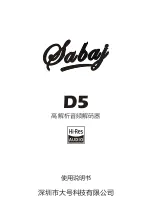
6
Funktionen:
Taster 1 + 2 rot
Vorsignal auf Vr0 („Fahrt erwarten“)
Taster 1 + 2 grün
Vorsignal auf Vr1 („Halt erwarten“)
Taster 1 grün + Taster 2 rot Vr2 („Langsamfahrt erwarten“)
* Der Anschlußpunkt „X“ dient der Vorsignalsteuerung
(Dunkeltastung), wenn dieses am Mast des Ausfahrsig
-
nals angebracht ist, d. h. bei Art. 4016, 4416, 4916 (siehe
weiter hinten).
Bemerkung:
Wenn sich das Vorsignal am Mast eines
Hauptsignals befindet, so ist der im obigen Anschlussplan
mit X bezeichnete Anschluß nicht mit der Signal-Betriebs
-
spannung (16 V DC= / AC~) zu verbinden (gestrichelte
Leitung), sondern mit dem mit “X” gekennzeichneten An
-
schlusspunkt des Hauptsignal-Anschlussplans. Hierdurch
wird das Vorsignal automatisch abgeschaltet, wenn das
Hauptsignal am gleichen Mast „Zughalt“ anzeigt (Dunkel
-
tastung).
3.1 Zugbeeinflussung
Wenn neben der Ansteuerung der Signal-LEDs eine Zug
-
beeinflussung erforderlich ist, so empfiehlt es sich, zwei
Schaltdecoder auf dieselbe Adresse einzustellen. Gleich
-
namige Ausgangskontakte beider Decoder schalten dann
simultan. Während ein Decoder gemäß vorstehender Dia
-
gramme die Ansteuerung der Lichtsignale übernimmt, kann
der zweite für die Zugbeeinflussung verwendet werden.
Wenn mit den Schaltkontakten des Decoders, Art. 5213
Gleisabschnitte stromlos geschaltet werden sollen, welche
digitalen Fahrstrom führen, so müssen die Schaltkontakte
jeweils mit einem Widerstand 1,5 kOhm / 0,25 Watt über
-
brückt werden. Dieses ist notwendig, damit die Lokomoti
-
ven auch beim Halt ihre Digitalinformation behalten.
Zum Steuern von Viessmann Formsignalen eignet sich der
Magnetartikeldecoder, Art. 5211. Dieser bietet neben einem
Kurzschluss-Schutz auch die Möglichkeit, den Schaltstrom
einem separaten Trafo zu entnehmen und somit die Digi
-
talstromquelle (den „Booster“) zu entlasten.
Functions:
Button 1 + 2 red
distant signal to Vr0 („expect go“)
Button 1 + 2 green
distant signal to Vr1 („expect stop“)
Button 1 green and Button 2 red
distant signal to Vr2
(„expect reduced speed“)
* The connecting point “X“ serves to control the distant
signal (dark switching), if it is mounted to the same mast
as the exit signal (items 4016, 4416, 4916).
Remark:
If the distant signal is mounted to the mast of
a home signal, the connector with the label „X“ may not
be connected with the supply voltage (16V DC= / AC~)
but with the same labeled connector of the main signal‘s
circuit diagram. Then the distant signal will automatically
be switched off if the home signal indicates „stop“ (dark
switching).
3.1 Automatic train control
If you need to control the signal LEDs and do automatic
train control, you have to use two decoders, item 5213
and set them to the same address. So the outputs with
the same number are switched simultaneously. So you
can use one decoder to switch the color light signals like
shown in the diagrams above. The other decoder then can
be used for the automatic train control.
If you want to control digital track power current by the
switching contacts of the decoder, item 5213, you have to
bridge the contacts by a resistor of 1.5k ohms / 0.25 watts.
This is necessary to ensure that the locomotives keep the
digital information, even when it stops.
To control the viessmann semaphores you can use the
decoder for electromagnetic devices, item 5211. It has got
a short circuit protection and allows to take the switching
current from a separate transformer. So the digital booster
will be relieved


























